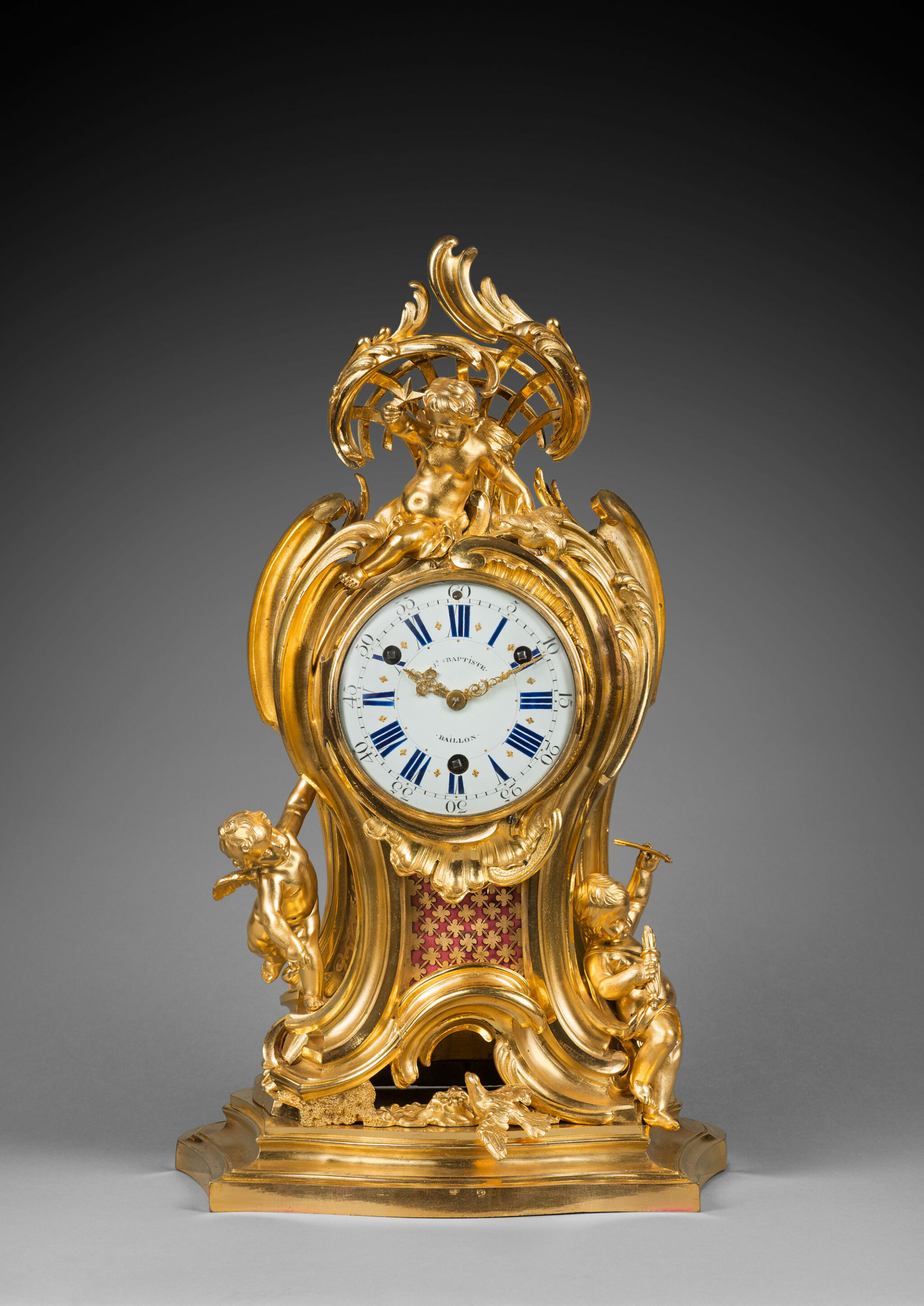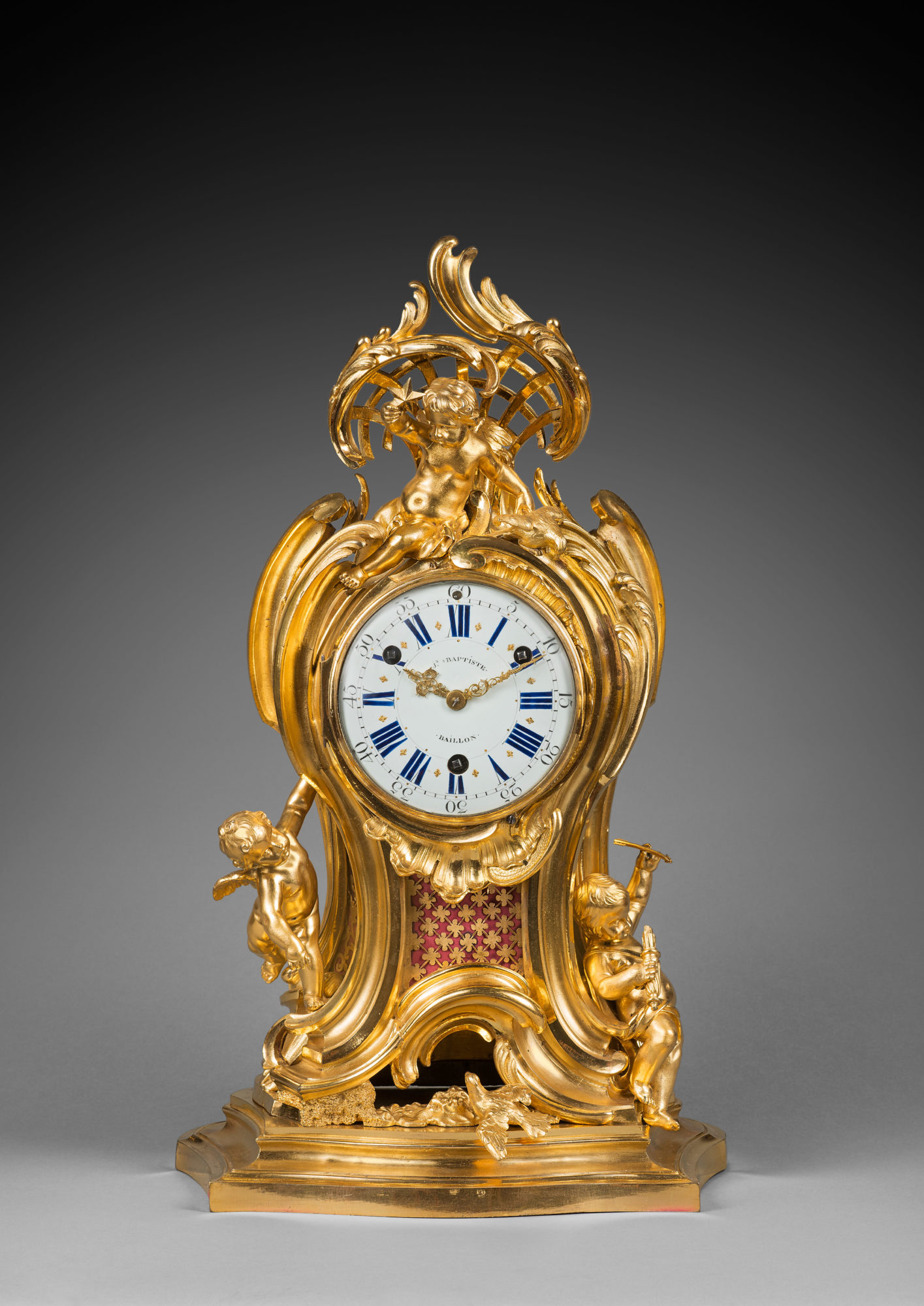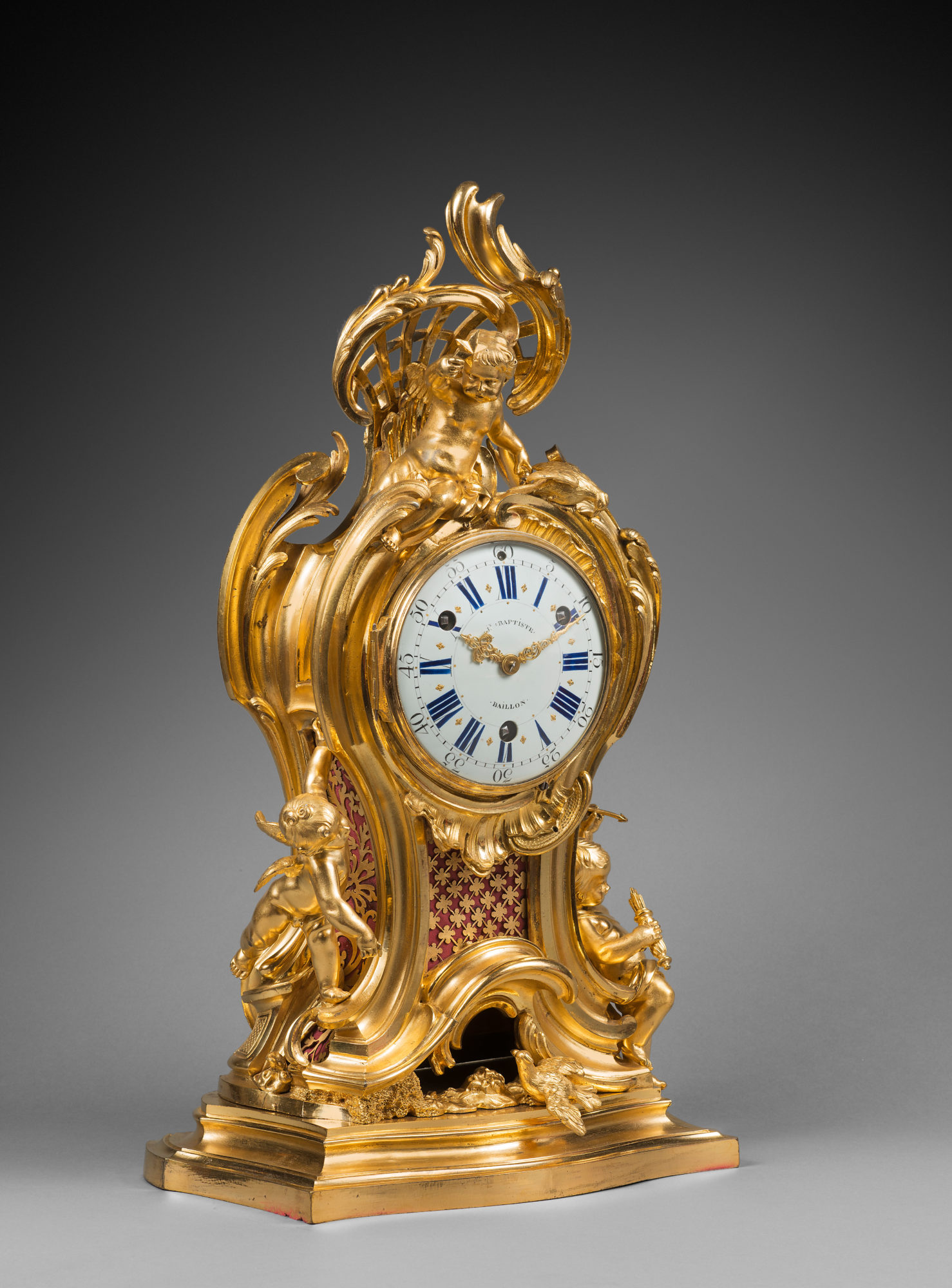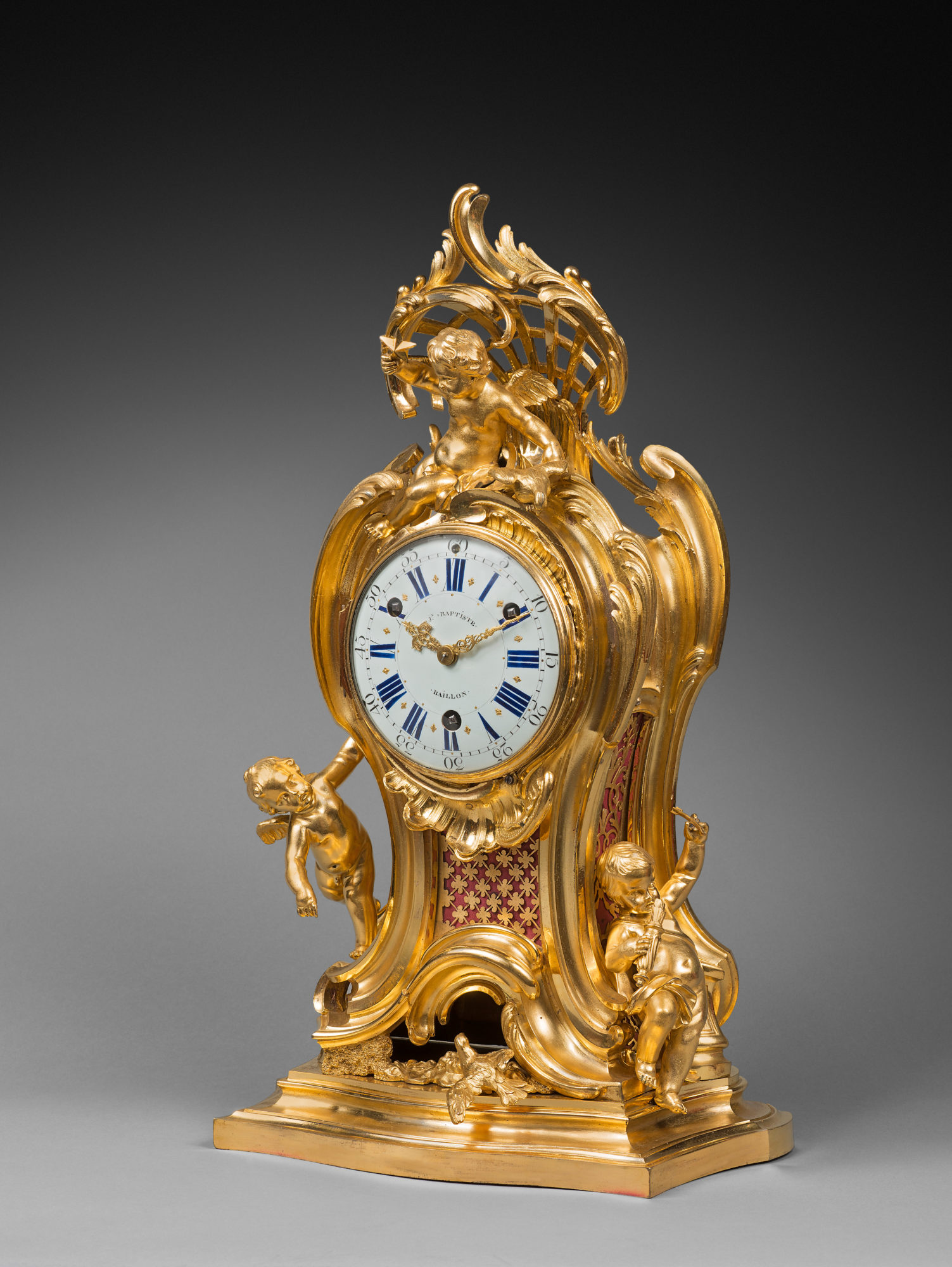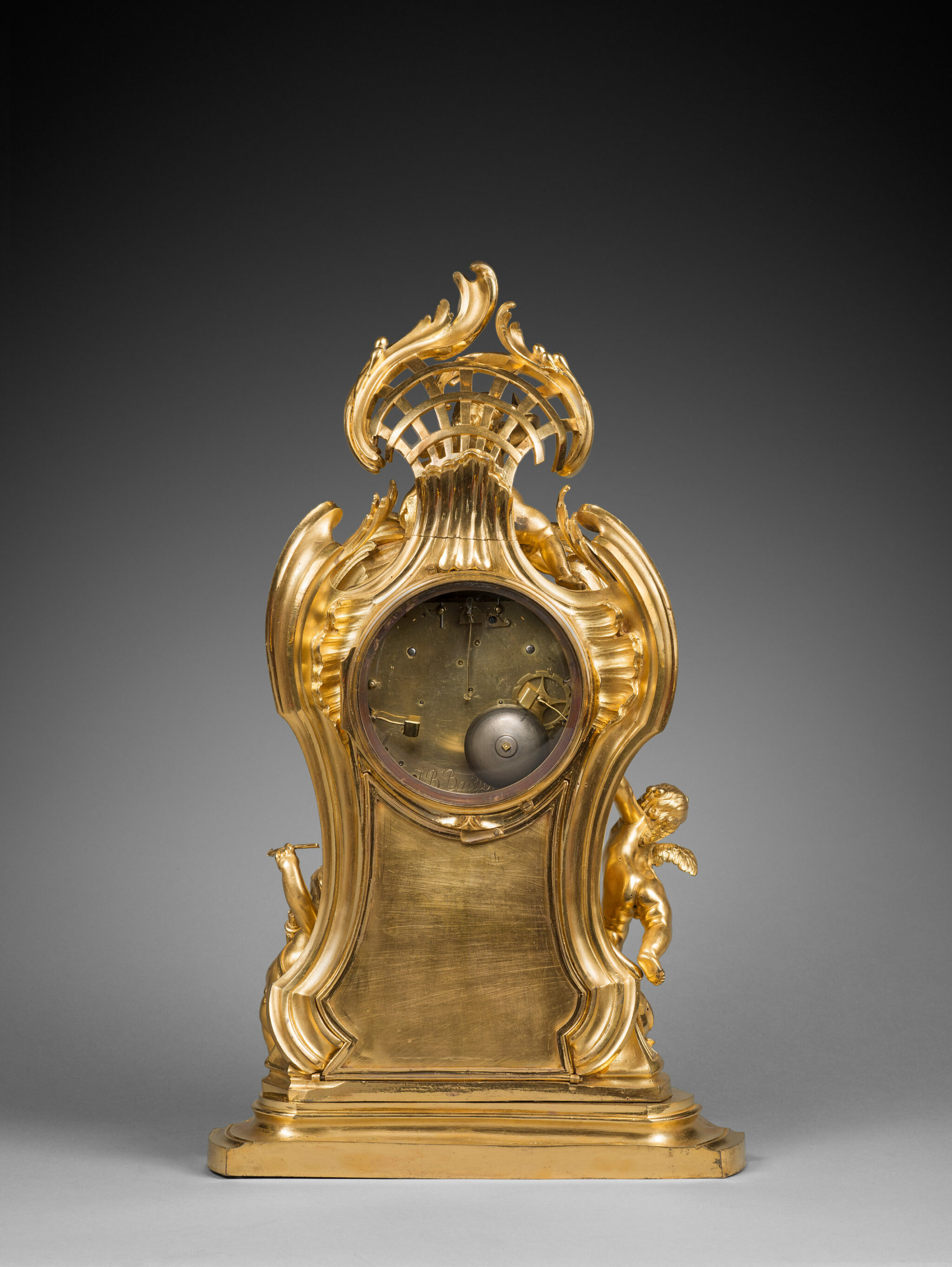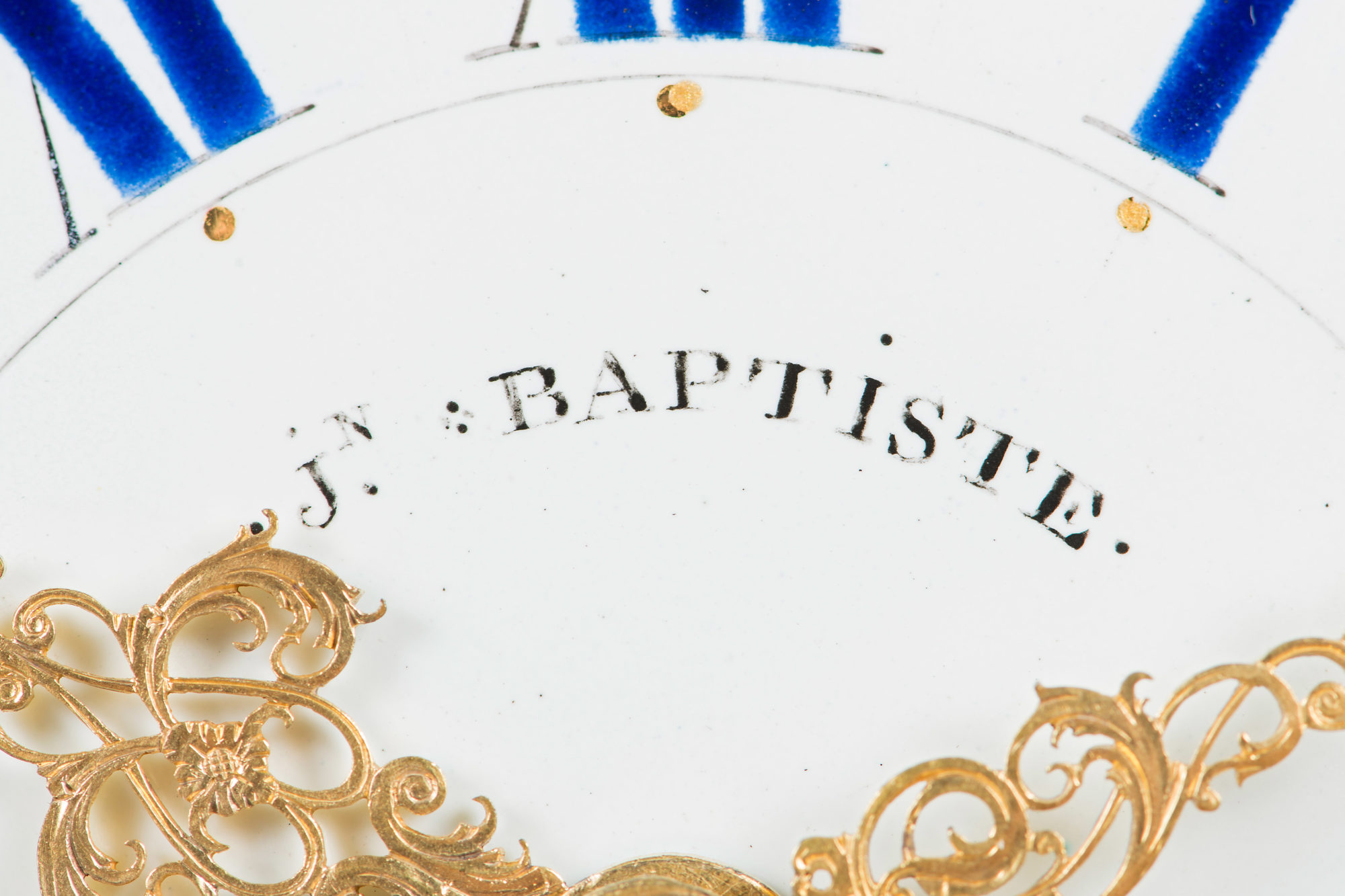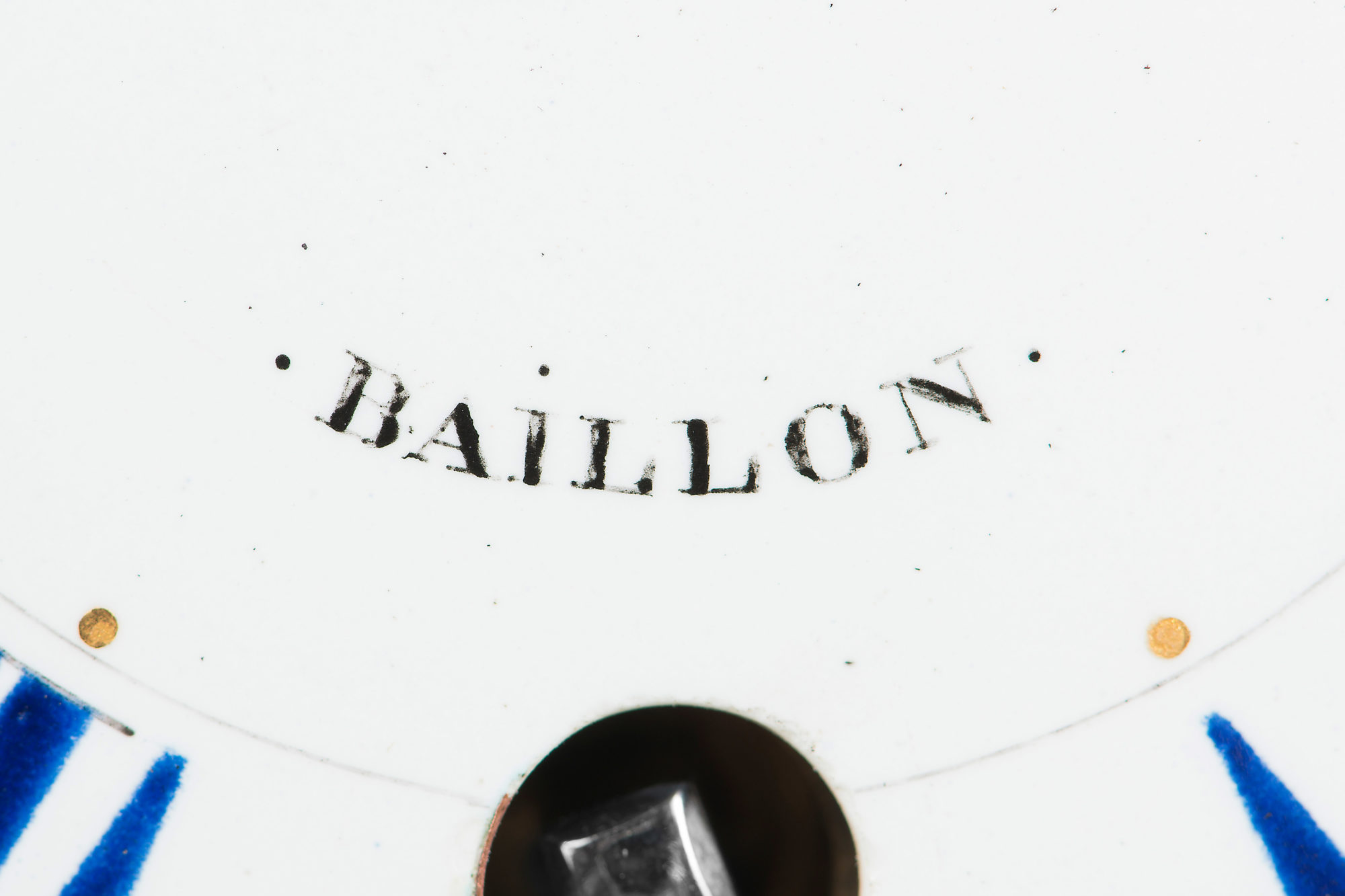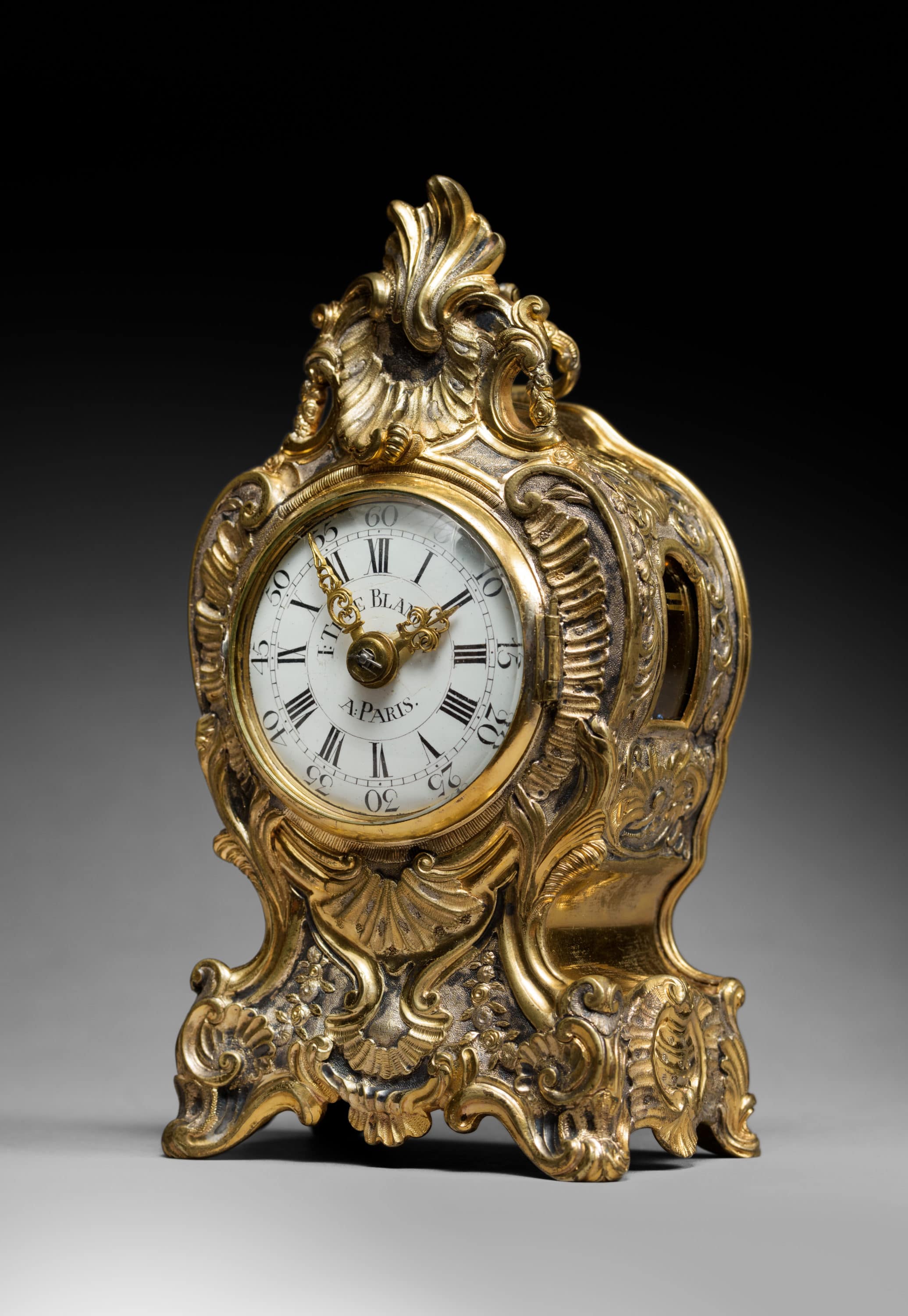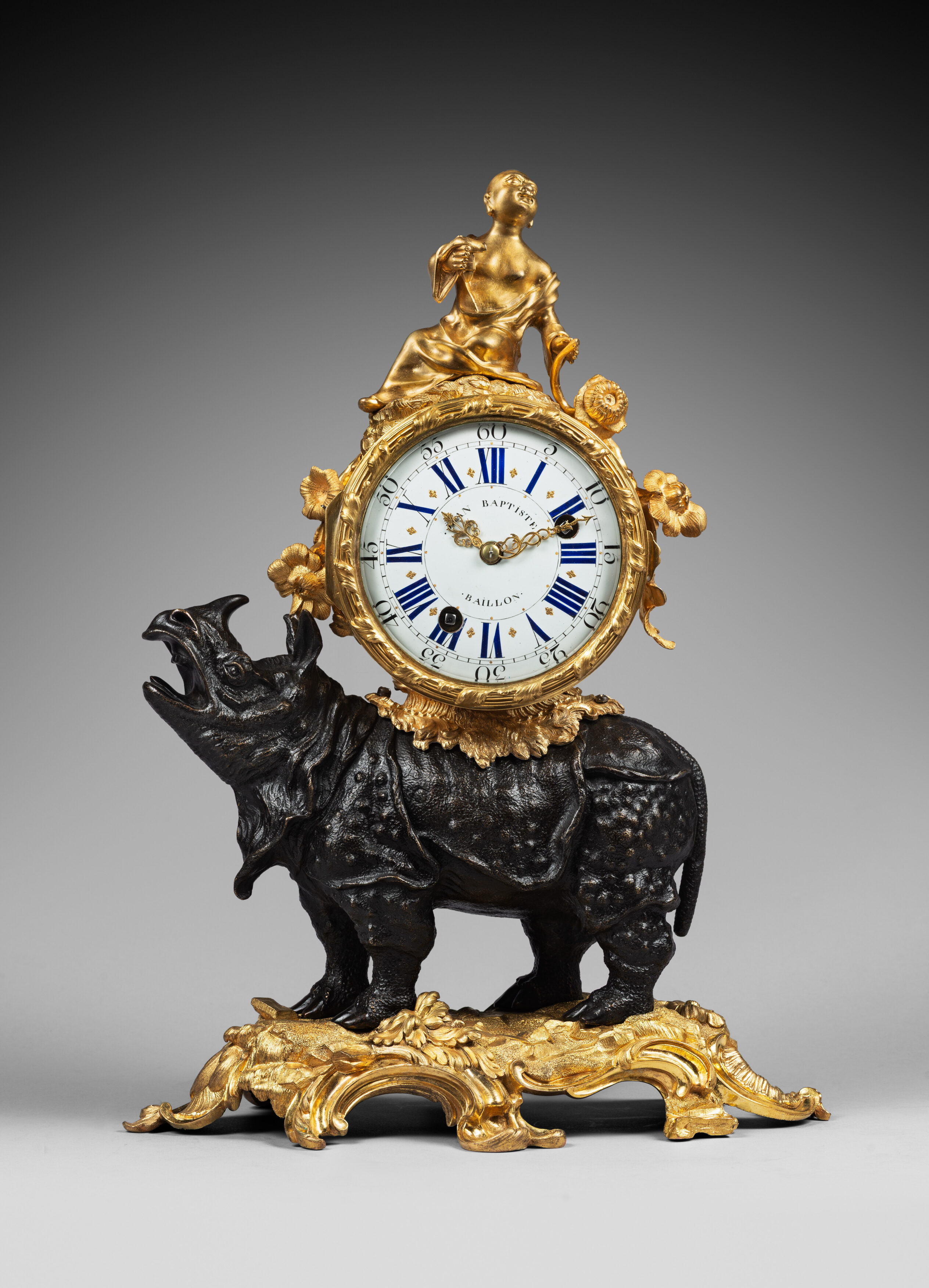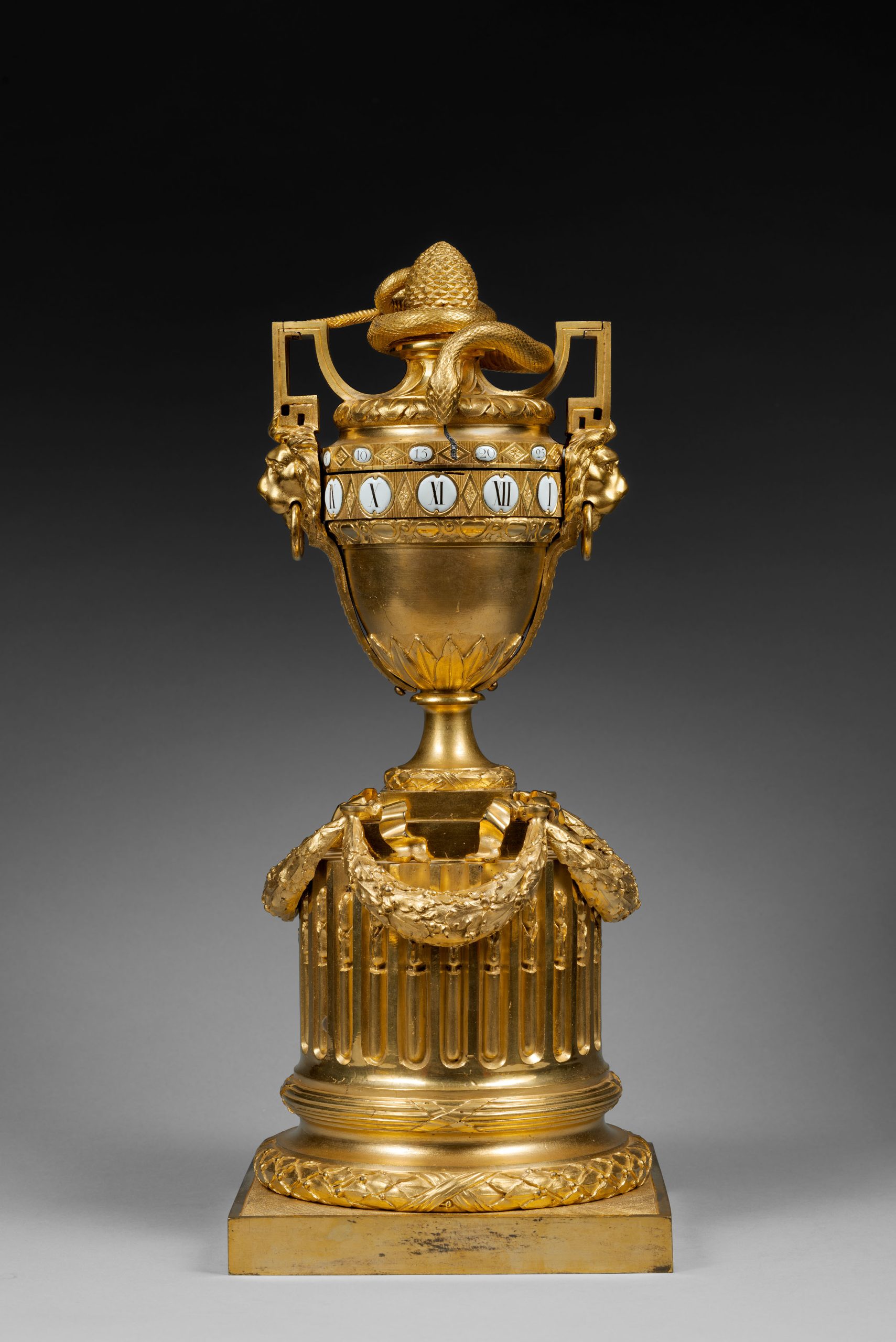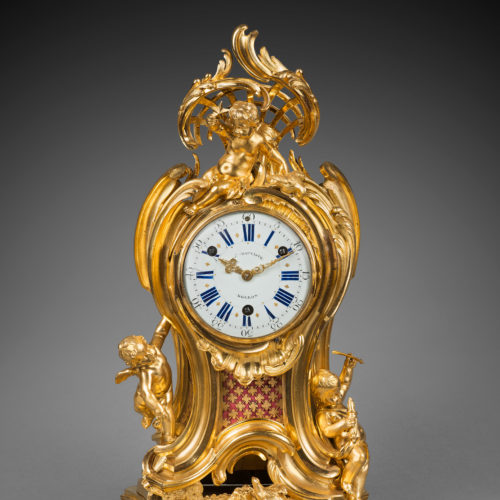Rare Gilt Bronze Mantel Clock with Matte and Burnished Finishing
“Daybreak”
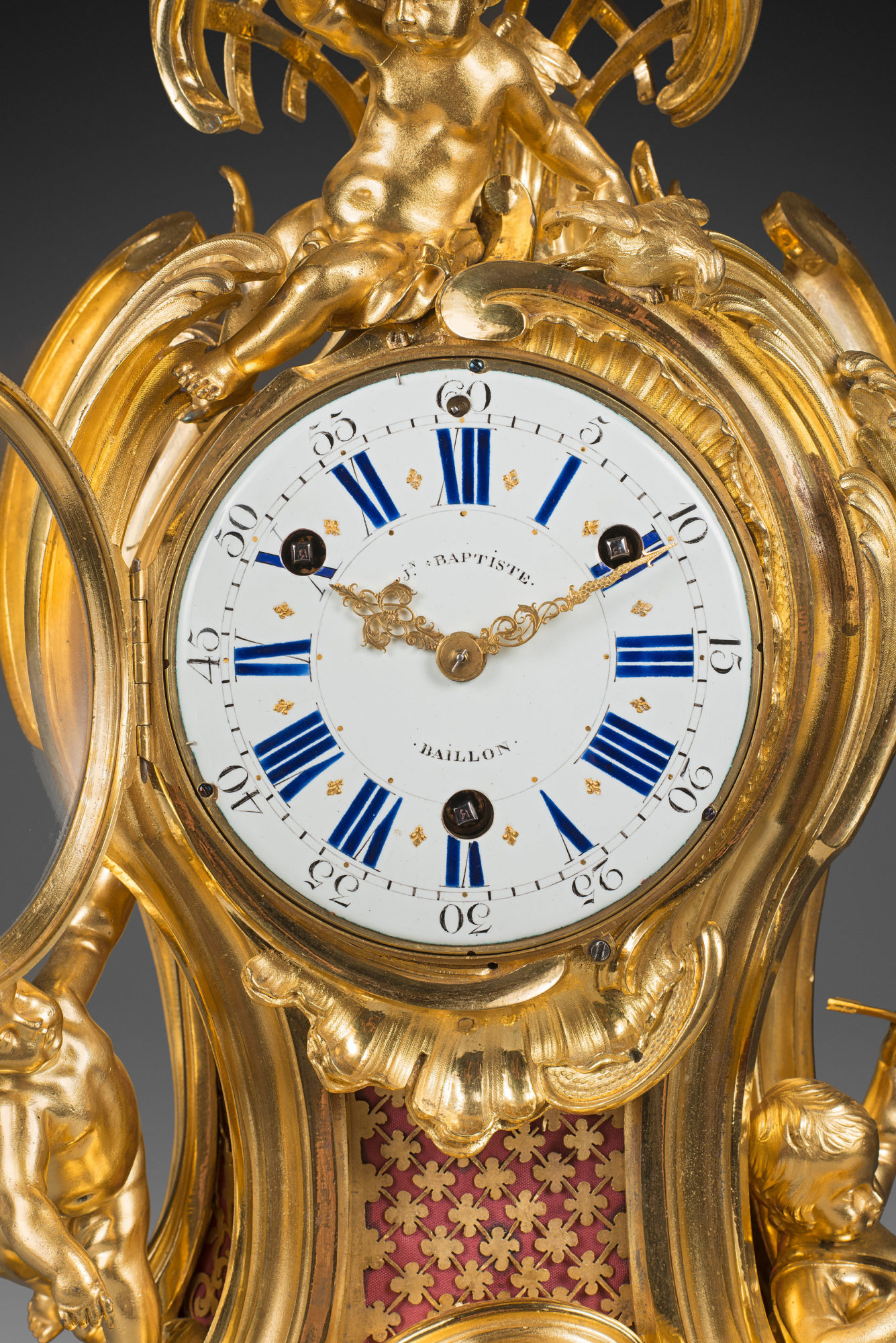
The Case Attributed to Jean-Joseph de Saint-Germain
Paris, Louis XV period, circa 1753
The round white enamel dial, signed “Jn. Baptiste Baillon”, indicates the Roman numeral hours and the Arabic fifteen-minute intervals by means of two pierced gilt bronze hands. The counter-enamel is signed “a.n. Martinière Pnaire (Pensionnaire) du Roy Ce 10 avril 1753”, which refers to the well-known Parisian enameler Antoine-Nicolas Martinière, who invented the one-piece enamel dial that revolutionized the appearance of Parisian clocks. The hour, half hour and quarter striking movement is housed in a magnificent rococo case that is made of finely chased gilt bronze with matte and burnished finishing. The clock is surmounted by an allegory of Daybreak, a winged Cupid holding a star, who is sitting under a latticework trellis that is adorned with C-scrolls, leaves and seeds. The sides of the case are decorated with C-scrolls and volutes. In the lower portion of the case there are two putti, one is holding a quiver and brandishing an arrow in his left hand. In the center there is a rococo motif featuring a dove sitting on a naturalistic rocky terrain. The shaped base is adorned with concave molding. The façade and sides of the case have reserves with trellis panels that are adorned with flowers, lined with burgundy-colored fabric.
Discover our entire collection of antique mantel clocks for sale online or at the gallery.
La Pendulerie is the specialist in fine and rare antique clocks, based in Paris.
The remarkable design of this rare mantel clock, along with the exceptional quality of its chasing and gilding, support our attribution to Jean-Joseph de Saint-Germain, one of the most talented Parisian bronziers of the reign of Louis XV. Today only a few identical clocks are known. Among them, one clock, whose dial is signed “Ferdinand Berthoud”, was formerly in the collection of Mario Crijns in Breda; it is illustrated in P. Heuer and K. Maurice, European Pendulum Clocks, Decorative Instruments of Measuring Time, Munich, 1988, p. 27, fig. 23. A second example is illustrated in P. Kjellberg, Encyclopédie de la pendule française du Moyen Age au XXe siècle, Les éditions de l’Amateur, Paris, 1997, p. 119, fig. D.
Jean-Baptiste III Albert Baillon (? - 1772)
Was one of the most skilled and innovative clockmakers of his day. Baillon achieved almost unprecedented success to become, in the words of F.J. Britten, “the richest watchmaker in Europe”. One of the most important clockmakers of the 18th century, he was no doubt the most famous member of an important horological dynasty. His success was largely due to his ability to organise a vast and thriving private factory in Saint-Germain-en-Laye, which was unique in the history of 18th century horology.
Managed from 1748-57 by Jean Jodin (1715-61) it remained in activity until 1765 when Baillon closed it. Renowned horologist Ferdinand Berthoud was impressed by its scale and the quality of the pieces produced; in 1753 he noted: (Baillon’s) “house is the finest and richest Clock Shop. Diamonds are used not only to decorate his Watches, but even Clocks. He has made some whose cases were small gold boxes, decorated with diamond flowers imitating nature. His house in Saint-Germain is a kind of factory. It is full of Workmen continually labouring for him…for he alone makes a large proportion of the Clocks and Watches [of Paris]”. He supplied the most illustrious clientele, not least the French and Spanish royal family, the Garde-Meuble de la Couronne as well as distinguished members of Court and the cream of Parisian society.
Baillon’s father, Jean-Baptiste II (d. 1757) a Parisian maître and his grandfather, Jean-Baptiste I from Rouen were both clockmakers, as was his own son, Jean-Baptiste IV Baillon (1752 – c.1773). Baillon himself was received as a maître-horloger in 1727. In 1738 he secured his first important appointment as Valet de Chambre-Horloger Ordinaire de la Reine. Sometime before 1748 he was made Premier Valet de Chambre de la Reine and in 1770, Premier Valet de Chambre and Valet de Chambre-Horloger Ordinaire de la Dauphine Marie-Antoinette. By 1738 he was established, appropriately, in the Place Dauphine, and after 1751 in the rue Dauphine.
Baillon used only the finest cases and dials. The latter were supplied by Antoine-Nicolas Martinière and Chaillou while his cases were supplied by Jean-Baptiste Osmond, Balthazar Lieutaud, the Caffiéris, Vandernasse, Edmé Roy and especially Jean-Joseph de Saint-Germain (1719-91).
His success allowed Jean-Baptiste Baillon to amass a huge fortune, valued at the time of his death on April 8, 1772 at 384,000 livres. His collection of fine and decorative arts was auctioned on June 16, 1772, while his remaining stock, valued at 55,970 livres, was offered at sale on February 23, 1773. The sale included 126 finished watches, totalling 31,174 livres and 127 finished watch movements at 8,732 livres. His clocks, with a total value of 14,618 livres, included 86 clocks, 20 clock movements, seven marquetry clock cases, one porcelain clock case and eight bronze cases.
Today one can admire Baillon’s work in some of the world’s most prestigious collections, including the Louvre, the Musée des Arts Décoratifs, the Musée National des Techniques, the Petit Palais and the Jacquemart-André Museum in Paris; Versailles; the Musée Paul Dupuy in Toulouse; the Residenz Bamberg; the Neues Schloss in Bayreuth; the Museum für Kunsthandwerk, Frankfurt; the Residenz in Munich and the Schleissheim Castle. Further museums include the Royal Art and History Museum in Brussels; the Spanish Patrimonio Nacional; the Metropolitan Museum in New York; the Newark Museum; the Walters Art Gallery in Baltimore and Dalmeny House in South Queensferry.
Jean-Joseph de Saint-Germain (1719 - 1791)
He was probably the most renowned Parisian of the mid 18th century. Active as of 1742, he did become a master craftsman until July 1748. He became famous for his many clock and cartel cases, such as his Diana the Huntress (an example is in the Louvre Museum), the clock supported by two Chinamen (a similar example is in the Musée des Arts décoratifs in Lyon), as well as several clocks based on animal themes, including elephant and rhinoceros clocks (an example in the Louvre Museum). In the early 1760’s he played an important role in the renewal of the French decorative arts and the development of the Neo-classical style, an important example of which may be seen in his Genius of Denmark clock, made for Frederic V and based on a model by Augustin Pajou (1765, in the Amalienborg Palace, Copenhagen). Saint-Germain also made several clocks inspired by the theme of Learning, or Study, based on a model by Louis-Félix de La Rue (examples in the Louvre Museum, the Gulbenkian Foundation, Lisbon, and the Metropolitan Museum in New York). Along with his clock cases, Saint-Germain also made bronze furniture mounts, such as fire dogs, wall lights, and candelabra. His entire body of work bears witness to his remarkable skills as a chaser and bronzeworker, as well as to his extraordinary creativity. He retired in 1776.
Discover our entire collection of rare clocks on La Pendulerie Paris.
Antoine-Nicolas Martinière (1706 - 1784)
Antoine-Nicolas Martinière was one of the most important Parisian enamellers of the reign of Louis XV. The son of enameller Nicolas Martinière, in September 1736 he married Geneviève Larsé, the daughter of clockmaker François Larsé, and became a master in Paris on July 3, 1720. He was described at the time as being a Marchand verrier-fayancier-émailleur-patenötrier (Merchant glassmaker- faience maker-enameller-maker of rosaries). His workshop was mentioned as being in the rue Neuve Nôtre Dame in 1736, the rue des Ursins in 1738, the rue Dauphine in 1740, and the rue des Cinq Diamants as of 1741. He quickly gained fame and became very successful, receiving the title of Emailleur et Pensionnaire du Roi in 1741 (translates to “Enameller and Resident of the King”). From 1741 to 1742 he made the famous perpetual almanac for Louis XV that is today in the Wallace Collection in London. He worked with many famous artisans, such as the bronze caster Jean-Joseph de Saint-Germain and the clockmakers Jean-Baptiste III Albert Baillon, Etienne Le Noir and Jean-Baptiste Gosselin. After several decades of professional activity, he died in Paris on August 27, 1784. At the time he lived in rue Quincampoix, Saint-Merry Parish.
